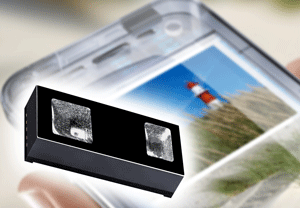- News
5 September 2011
Osram combines IR LED emitter with proximity and ambient light sensors to cut crosstalk in smart-phones
 Osram Opto Semiconductors GmbH of Regensburg says that its new SFH 7773 digital sensor makes it easier to install both proximity and ambient light sensing in smart-phones and similar devices by combining the functions of a digital ambient light sensor and a digital proximity sensor in a single compact unit.
Osram Opto Semiconductors GmbH of Regensburg says that its new SFH 7773 digital sensor makes it easier to install both proximity and ambient light sensing in smart-phones and similar devices by combining the functions of a digital ambient light sensor and a digital proximity sensor in a single compact unit.
Combining the emitter and detector chips together – three devices in all – also simplifies the elimination of crosstalk in many applications, reducing design requirements, since designers no longer have to install a separate IR emitter to enable the proximity sensor function.
The SFH 7773 detects objects up to a distance of 15cm (5.9 in.) while simultaneously measuring the intensity of the ambient light. Measuring just 5.3mm x 2.5mm x 1.2mm, its black package is barely noticeable behind the transparent covers of smart phones, says Osram Opto. Due to highly efficient chip technology, power consumption is low (a maximum of 5A flows in stand-by mode and 300A in operational mode) suiting portable devices.
Proximity sensors detect objects by receiving the reflection of an emitted light signal. But the cover of a smart-phone, for example, also reflects light back to the sensor. This crosstalk is usually intercepted by installing an optical barrier or placing the emitter at a sufficient distance from the cover to prevent the cover reflections from reaching the detector. However, both methods are rather complex and cumbersome. Osram Opto says that, with the SFH 7773, designers no longer have to worry about crosstalk because, inside the device, the emitter and the detector chip are located sufficiently far apart from each other and apertures are integrated into the package to prevent crosstalk, or at least to significantly reduce it.
Now, to a large extent, designers are free to select the integration time of the detector and thus the detection range of the proximity sensor via the I2C interface. That way, the ambient light sensor can also adjusted to the transparency of the smart-phone cover. A variety of sensitivity levels is available, ranging from 3 to about 65.500 lux and 0.03 to 655 lux.
“This means that now, for the first time, our customers can optimize the device for their respective application — from the operating distance to the sensitivity of the ambient light sensor,” notes product marketing manager Bianka Schnabel. “Due to this considerably simplified design and flexibility of use, combined ambient light and proximity functions become more attractive for the mid-price segment of smart-phones and other portable devices,” she adds.
